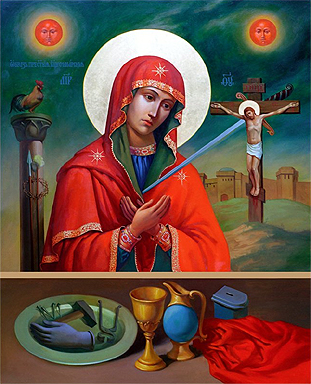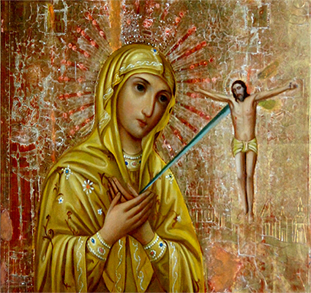Third Tuesday after Easter
Samara Mother of God, Novomoskovsk, Dnipropetrovsk, Ukraine
 |
Similar to another Ukrainian icon, the Akhtyrskaya,
the Mother of God of Samara is portrayed beside a crucifix, on Christ's
right side, as in most Crucifixion and Deesis scenes. But in addition to
the crucifix, the Samara icon depicts many other emblems of Christ's
passion, including the sun that darkened, the moon; the cock that crowed;
the temple whose veil was rent; nails, hammer, and pliers; chalice and
pitcher. A sword extends from Christ's side to his mother's heart, as
foretold at his infant presentation.
Where the Akhtyrskaya gazes at her crucified son with hands joined in
prayer, the Samarskaya looks neither at Christ nor directly at the viewer,
hands crossed on her breast. The Akhtyrskaya appears to intercede with
Christ, the Samarskaya to share his suffering and death.
In 1711, when Russians drove the Cossacks out of their stronghold in southern Ukraine, many fled to the Crimean Khanate. In 1734, they were allowed to return. Around 1736, according to local tradition, some of the former exiles placed an icon of the Mother of God in an Orthodox church in their reestablished territory on the Dneiper, the Zaporizhian Sich. After moving to the town of Novi Kaydaki, also in the Sich, the icon developed a reputation for miracles, which the church rector reported to the Cossack leader in 1770. Bypassing church protocol, the Otaman donated an icon cover of gold, silver, and precious stones, and had the image moved to a place of honor in a separate chapel. Five years later, under Catherine the Great, Russia abolished the Zaporizhian Sich and established a new Orthodox eparchy in the region. The new hierarchy had the miraculous icon moved west from Novi Kaydaki to the bishop's residence at Holy Cross Monastery in Poltava, the new diocesan seat. In 1804 they moved it to the cathedral sacristy in Katerynoslav (now Dnipropetrovsk), not far from its old location of Novi Kaydaki. |
||||||
| Recent icon by Father O. Andrew Ponomarenko of Dnipropetrovsk | Three years later the bishop's steward obtained permission to move it 15 miles northeast to the Samara Monastery, which he managed also. Revered throughout the region, the icon processed twice annually from the island monastery through the villages of the eparchy, April 15 to June 15 and August 15 to October 15. | ||||||
 |
After the 1917 revolution, Samara Monastery was closed and
the icon lost. Reopened in 1998, the monastery maintains a shrine with a
copy of the image in which Mary, Christ, and the sword have been
retouched, while the other details have faded. For the icon's 275th
anniversary in 2011, the annual procession was revived in a less elaborate
way. Lasting several days, the procession takes the image from St.
Nicholas Samara Monastery to the St. Nicholas Church in Novi Kaydaki,
stopping along the way at churches in Novomoskovsk and Dnipropetrovsk.
Orthodox churches in the region celebrate the Samara Mother of God on the
third Tuesday after Easter, during Myrrh-Bearers Week, when Orthodoxy
honors the women who visited Christ's tomb on the morning of his
resurrection.
Sources include:
|
||||||
| Icon now in the Samara Monastery |